American Breeds of Cat – At a Glance
- American Bobtail
- American Curl
- American Shorthair
- American Wirehair
- Balinese
- Bambino
- Bengal
- Bombay
- Cheetoh
- Exotic
- Himalayan
- LaPerm
- Munchkin
- Nebelung
- Ocicat
- Pixiebob
- Ragamuffin
- Ragdoll
- Selkirk Rex
- Snowshoe
- Somali
American Curl

- Origins: 1981, California, USA
- Lifespan: 12-15 years
- Eyes: All colours
- Energy: Medium
- Temperament: Inquisitive, intelligent, loving
- Weight: Males 4-5 kg (8.8 – 11 lbs), females 3.5-4 kg (7.8 – 8.8 lbs)
- Colours: All colours and patterns accepted
- Grooming: Weekly
The American Curl is a unique breed of cat with ears that curl back away from the face. Joe and Grace Ruga (Curlniques Cattery) found two homeless kittens in Lakewood, California. Both kittens had unusual curled back ears which were named Panda and Shulamith. Sadly, Panda vanished a few weeks later, but Shulamith remained with the Rugas and gave birth to four kittens, two of whom had the same curled back ears. From there, the Rugas established a breeding programme.
Personality:
Inquisitive, intelligent, even-tempered, friendly and loving, the American Curl likes to be a part of everything you are doing and retain their kitten-like nature well into adulthood.
The American Curl gets along with everyone and makes a great family pet.
American Bobtail
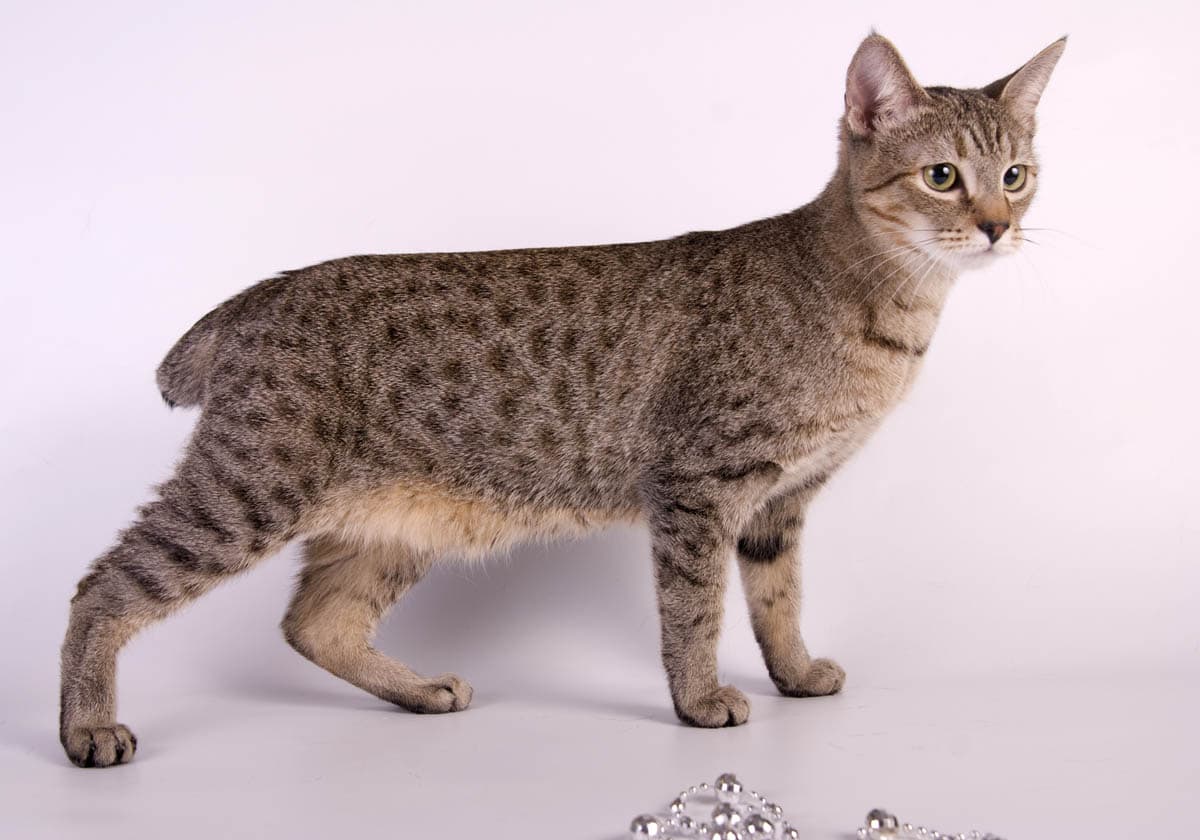
- Origins: 1960s, Arizona and Iowa
- Lifespan: 12-14 years
- Eyes: Hazel, green, yellow, green
- Energy: Medium
- Temperament: Playful, outgoing, curious, loving
- Weight: Males 5.5 – 7.2 kg (12 – 16 lbs), females 4-5 kg (8.8 – 11 lbs)
- Coat: Short or long
- Colours: All colours
- Grooming: Daily (long), weekly (short)
The American Bobtail is a large, stocky cat with a bobbed tail. John and Brenda Sanders found a short-tailed male tabby during a vacation near an Indian reservation in Arizona. He was brought home to Iowa and mated to a female Siamese called Mishi. The resulting litter consisted of kittens with short tails like their father.
Personality:
American Bobtails are intelligent and playful; and easy to train or walk on a leash. This is a breed that forms close bonds with its humans but can be somewhat shy towards strangers.
The American Bobtail gets along with children and other pets and makes an exceptional family pet.
American Shorthair

- Origins: Europe and USA
- Lifespan: 12-14 years
- Eyes: Hazel, green, gold, blue
- Energy: Medium
- Temperament: Independent, friendly, easygoing and playful
- Weight: Males 5 – 6 kg (11 – 13.2 lbs), females 4 – 5 kg (8.8 – 11 lbs)
- Colours: Every colour is accepted
- Grooming: Weekly
The American Shorthair is a breed descended from European cats, brought to North America by early settlers to keep rodents and vermin away from food stores. Records suggest cats came to North America on the Mayflower in 1620 and once in America, cats remained close to their humans and could be found wherever settlements formed.
These cats were known as shorthairs, and later domestic shorthairs before the name was changed to American Shorthair in the 1960s. First appearing at cat shows in the early 1900s, breeders began to choose the finest example of domestic cats to create the breed. Champion Belle of Bradford (DOB 1st June 1900) arrived in the United States and was the first domestic shorthair to be registered with the Cat Fanciers Association. The first American born cat to be registered was Buster Brown, a male smoke, both cats were owned by Jane Cathcart.
Personality:
The American Shorthair is an easygoing and friendly breed that remain playful well into adulthood. They like to be around you, but not on you or in your face all the time and are a perfect companion for people who enjoy the company of a cat but not one who is excessively clingy.
This is a breed who gets along well with children and adults alike.
American Wirehair

- Origins: USA
- Lifespan: 12-14 years
- Eyes: Hazel, green, gold, blue
- Energy: Medium
- Temperament: Independent, friendly, easygoing and playful
- Weight: Males 5 – 6 kg (11 – 13.2 lbs), females 4 – 5 kg (8.8 – 11 lbs)
- Colours: Every colour is accepted
- Grooming: Weekly
The American Wirehair arose as a spontaneous mutation in 1966 when a farm cat from Council Rock Farm in Vernon, New York gave birth to a litter of kittens. One kitten, a red and white male, had an unusual wiry coat. The kitten was sold to local cat breeder Joan O’Shea who named him Council Rock Farms Adams of Hi-Fi, or Adam for short. Joan adopted another kitten from the farm, who was named Tip-Top of Hi-Fi and it is believed she was either a sibling or relative of Adam.
Adam and Tip-Top produced a litter of kittens, two of which had the same unusual coat as their father. These kittens were sold on to other breeders to develop a breed, and the American Wirehair was accepted for registration with the CFA in 1967 and awarded championship status in 1978.
Personality:
American Wirehairs are affectionate cats who love attention. They are intelligent, easygoing and get along well with children and other pets.
Balinese
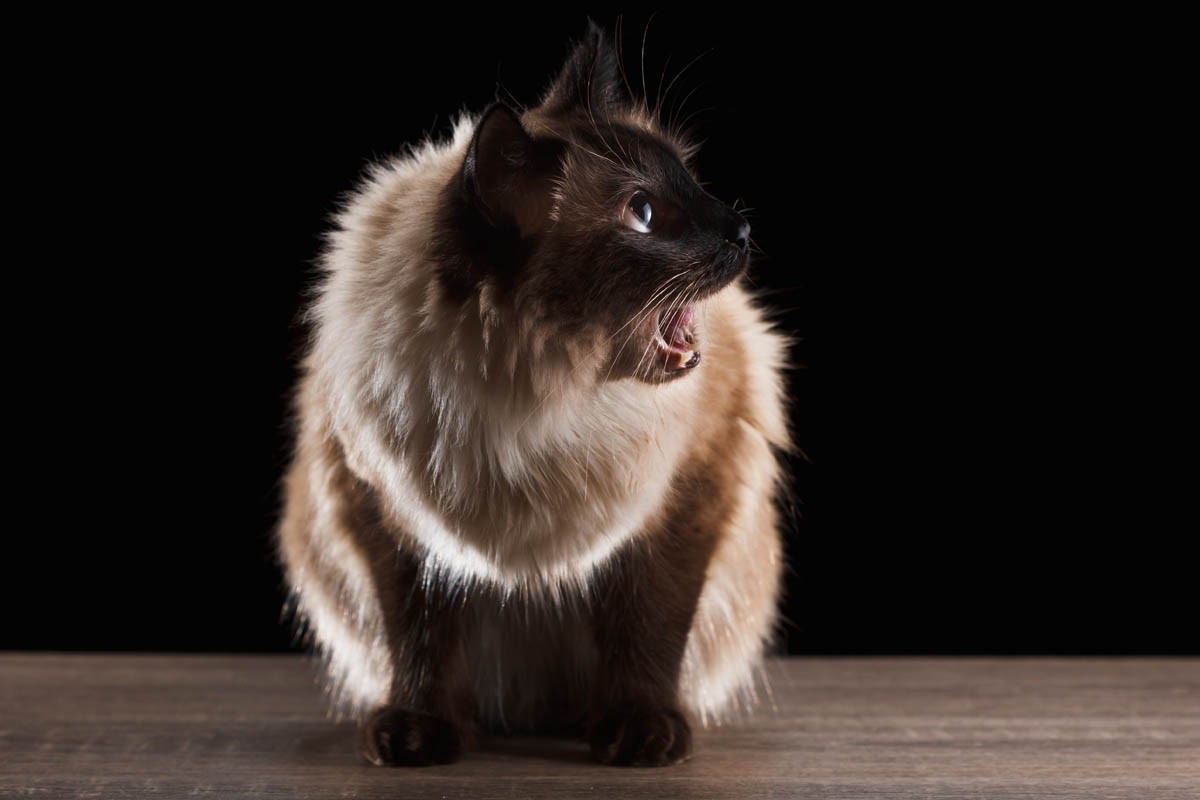
- Origin: 1950, California, USA
- Lifespan: 12-18 years
- Eyes: Blue
- Energy: Medium
- Temperament: Friendly, playful, easygoing, active
- Weight: Males 5 kg (11 lbs), females 4-5 kg (8.8 – 11 lbs)
- Colours: Seal, chocolate, blue and lilac
- Eyes: Blue
- Grooming: Daily
From time to time longhaired cats would crop up in Siamese breeding programmes. These cats were sold as pets until 1950 when Marion Dorsey of Rai-Mar cattery developed a breeding programme to create longhaired Siamese. By the early 1960s, Helen Smith of MerryMews cattery came on board, and it is Helen who came up with the name Balinese, likening the cats to Balinese dancers.
Personality:
Balinese cats are intelligent and loving cats who bond closely with their human family. They like to follow you from room to room and like their Siamese cousins, are a talkative breed.
They get along well with people and other pets and make a great family pet.
Bambino
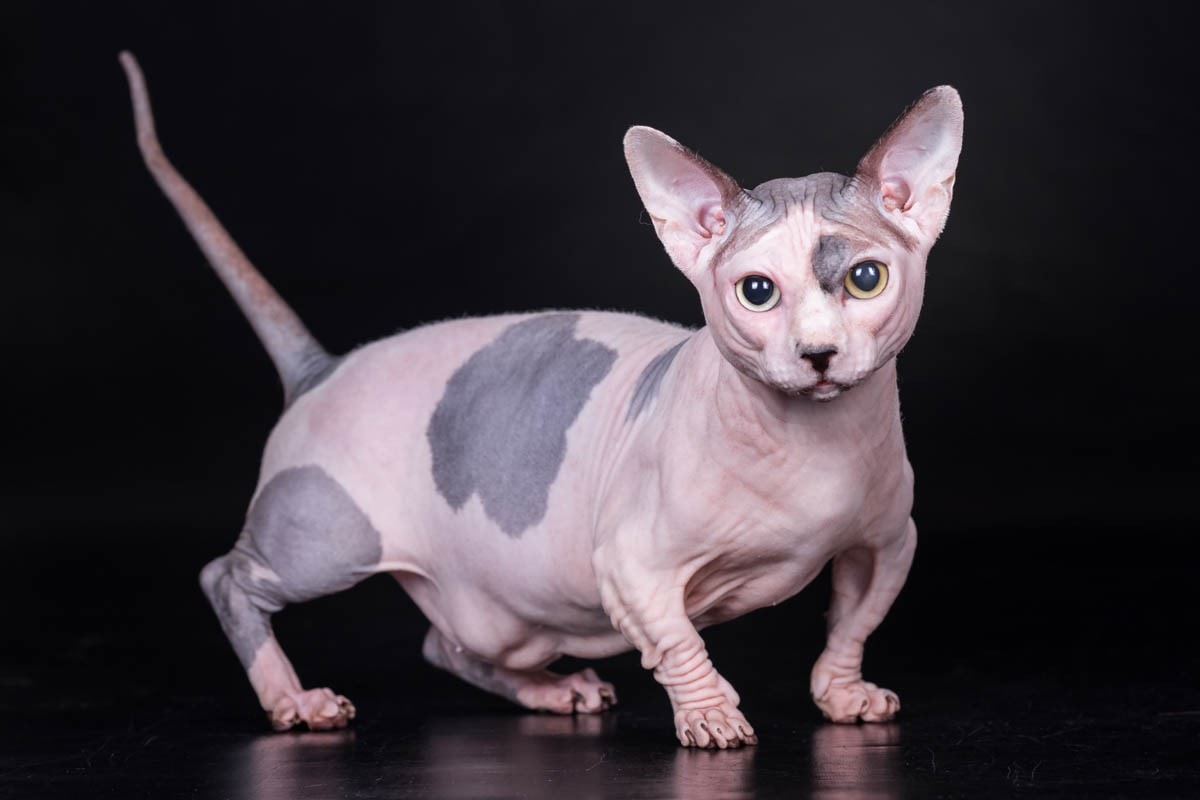
- Origin: 2005,
- Lifespan: Unknown at this time
- Eyes: All eye colours
- Energy: High
- Temperament: Friendly, playful, easygoing, active
- Weight: Males 4.5 kg (9.9 lbs), females 4 kg (8.8 lbs)
- Colours: All coat colours and patterns
- Eyes: All eye colours
- Grooming: Weekly
The Bambino is a cross between the Munchkin and the Canadian Sphynx and was created by Pat and Stephanie Osbourne of HolyMoly Cattery.
The breed is recognised by the TICA as experimental; however, the CFA and ACFA will not recognise the Bambino.
Personality:
The Bambino is an active breed of cat who is outgoing, intelligent and likes to be a part of the family. They get along great with children and other pets.
Bengal
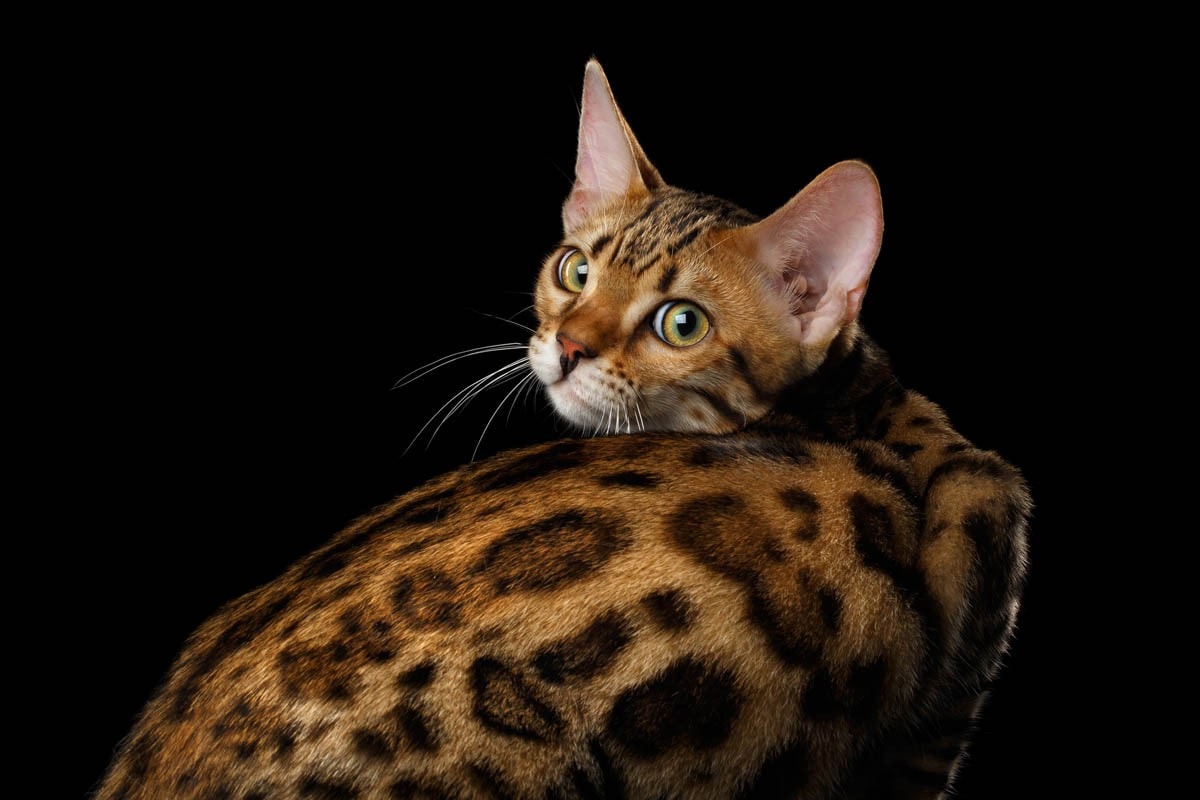
- Origin: 1980, California, USA
- Lifespan: 12-14 years
- Eyes: Green
- Energy: High
- Temperament: Intelligent, active, curious, playful
- Weight: Males 5-6 kg (11 – 13 lbs), females 4-5 kg (8.8 – 11 lbs)
- Coat: Short
- Eyes: Green, yellow and blue (Snow Bengal)
- Colours: Tabby, sepia, mink, and silver
- Grooming: Weekly
The Bengal cat is a domestic breed created by crossing domestic cats with the Asian Leopard cat (a small wild cat).
In 1963, Jean Mill purchased a female Asian Leopard cat named Malaysia from a pet store. Believing Malaysia was lonely, she put a black domestic shorthair in the cage, the two cats mated and produced a litter of two kittens. A male and a female named KinKin. The male was mauled, but KinKin survived. Cornell University predicted KinKin would be sterile; however, she was mated back to her father and delivered a black female and a spotted male. This project was abandoned due to the death of her husband.
Geneticist Dr Willard Centerwall was working on a programme that involved crossing Asian Leopard cats with domestics. Jean Mill obtained several F1 hybrids from this programme. While visiting India in 1982, Jean came across a feral domestic male living in the rhino enclosure at Delhi zoo who had markings similar to a leopard. This cat (Millwood Tory of Delhi) came back to the United States and was mated with the female hybrids to create the Bengal. Other domestic breeds were used in the breeding programme including Ocicats, Egyptian Maus, Abyssinians, Bombays and British Shorthairs.
The International Cat Association recognised the Bengal cat as a new breed in 1986 and awarded championship status in 1991.
Personality:
The Bengal is an active, energetic and intelligent breed that loves to climb and is known for its love of water.
Bombay
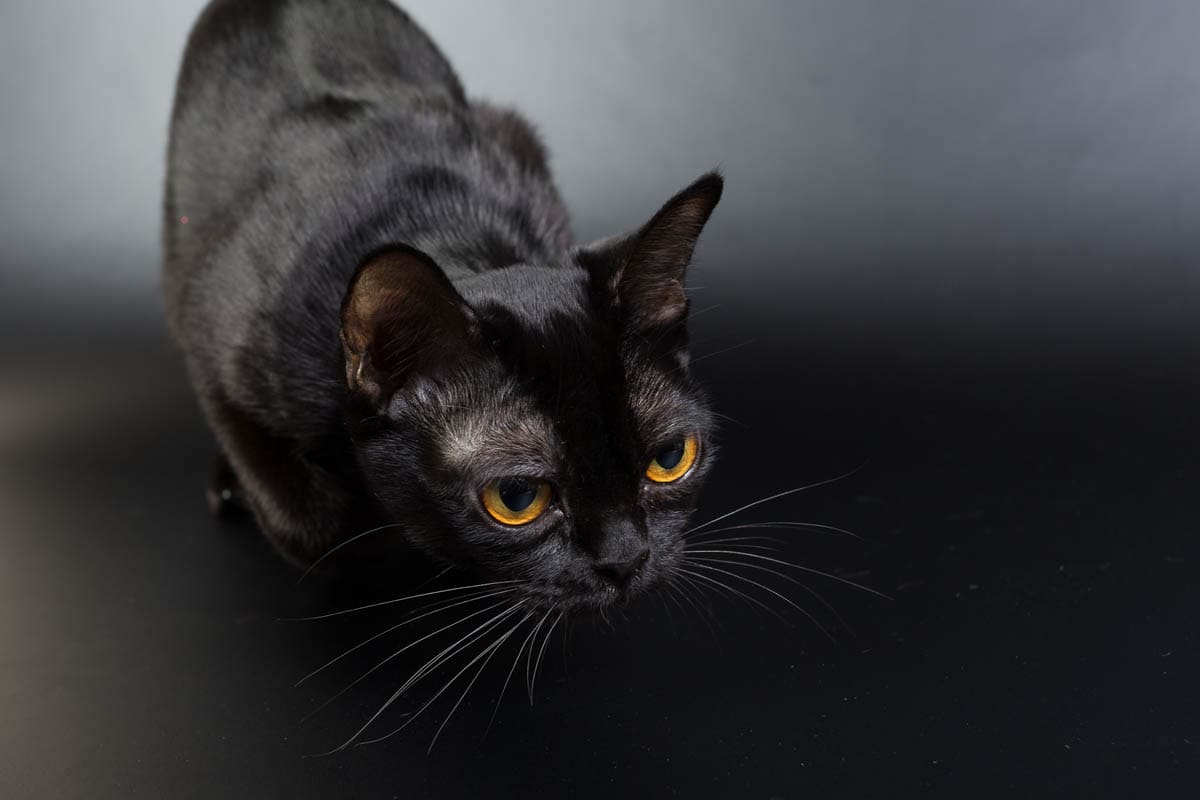
- Origin: 1965, Kentucky, USA
- Lifespan: 12-14 years
- Eyes: Gold to copper
- Energy: Medium
- Temperament: Playful, outgoing, curious, loving
- Weight: Males 4-5 kg (8.8 – 11 lbs), females 3.5-4 kg (7.8 – 8.8 lbs)
- Colours: Black
- Grooming: Weekly
The Bombay was developed by Nikki Horner of Shawnee Cattery who wanted to create a black Burmese with copper eyes by crossing sable Burmese cats with black American Shorthairs.
The CFA Board of directors accepted the Bombay breed for registration in June 1970, and the Bombay received full recognition by the CFA in 1976.
Personality:
The Bombay is similar in personality to the Burmese and is friendly, outgoing, sociable cat who love to be with their human family.
An intelligent breed, Bombays are easy to train to walk on a leash and love to play fetch.
Cheetoh
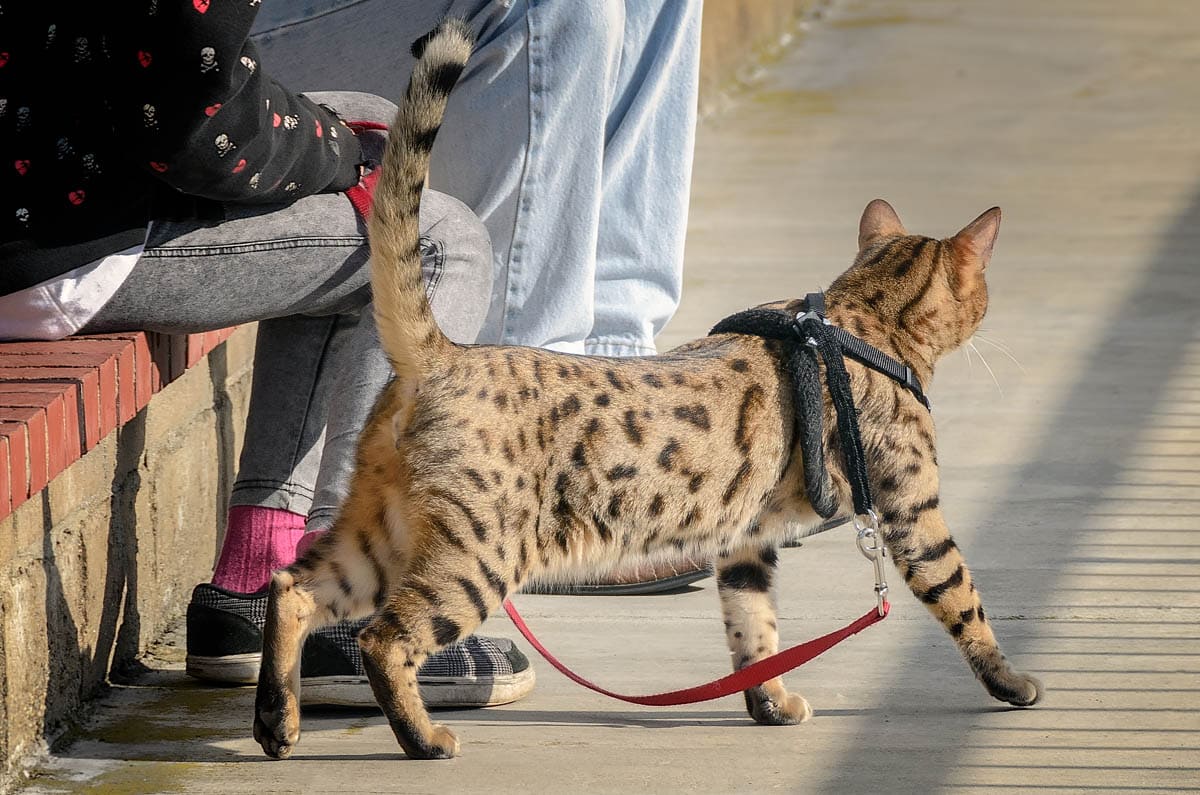
- Origins: 2003, United States
- Lifespan: 12-14 years
- Eyes: Green
- Energy: High
- Temperament: Friendly, outgoing, intelligent, dog-like
- Weight: Males 11-6 kg (8.8 – 13.2 lbs), females 4.5 -5.5 kg (9.9 – 12.1 lbs)
- Colours: Brown spotted
- Grooming: Weekly
One of the newest man-made cat breeds, the Cheetoh is a hybrid of the Bengal and Ocicat created by Carol Drymon of Wind Haven Ranch. The first litter arrived in 2003, and other breeders followed suit.
The Cheetoh is still relatively new to the cat fancy and is currently on the TICA registry as an experimental breed.
Personality:
The Cheetoh is intelligent, friendly, outgoing, affectionate and dog-like. They are easy to train to walk on a leash and play fetch. With a high activity level, plenty of opportunities to play.
Exotic Shorthair

- Origins: 1960s, United States
- Lifespan: 12-14 years
- Eyes: Hazel, green, yellow, brown, blue
- Energy: Low
- Temperament: Easygoing, sweet, loyal, quiet
- Weight: Males 11-6 kg (8.8 – 13.2 lbs), females 4.5 -5.5 kg (9.9 – 12.1 lbs)
- Colours: All coat colours and patterns
- Grooming: Requires weekly grooming
The Exotic Shorthair is a relative newcomer to the cat fancy which originated in the United States in the 1960s. The breed is the result of crossing American Shorthairs with Persian cats. Later other breeds were used as outcrosses including Burmese and Abyssinians. The only allowable outcross for the Exotic Shorthair now is the Persian. Because they are outcrossed to Persians, most litters will contain both short-haired and long-haired kittens.
Personality:
The Exotic is a laid-back and calm breed of cat who make a great companion for families as well as retirees.
Himalayan
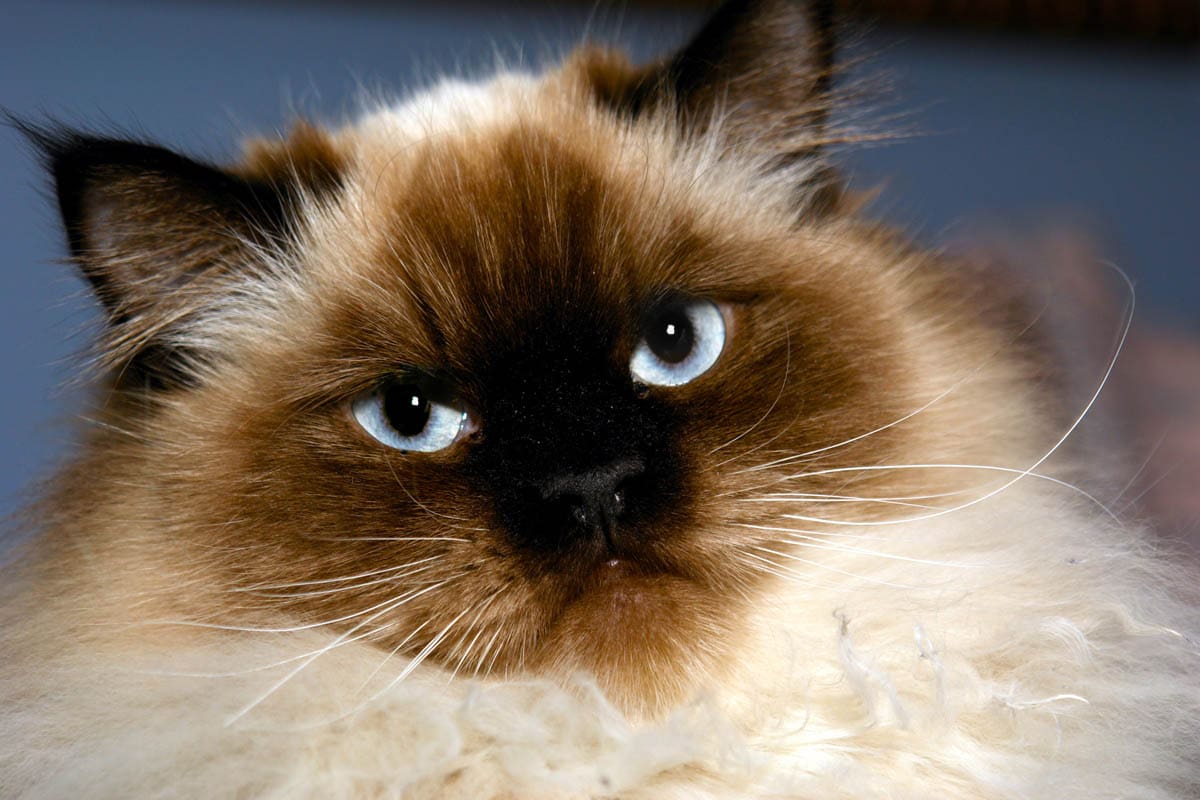
- Origin: San Diego, USA and Richmond, UK
- Lifespan: 12-14 years
- Eyes: Blue
- Energy: Low
- Temperament: Sweet, placid, friendly
- Weight: Males 5-6 kg (11 – 13.2 lbs), females 4-5 kg (8.8 – 11 lbs)
- Colours: Seal, chocolate, blue, lilac some cat councils may accept additional colours
- Grooming: Daily
The Himalayan is a pointed Persian that takes its name from Himalayan rabbits who have the same coat colour. The breed was developed by crossing Siamese cats with Persians to create a Persian-type with colourpoint markings.
Marguerita Goforth of Goforth Cattery in San Diego and Brian Sterling-Webb of Richmond in Surrey began establishing separate breeding programmes with the goal of creating a colour pointed Persian in the 1950s. The CFA recognised the Himalayan in 1957 but re-classified the breed in 1984 to a Persian subtype.
Personality:
Himalayan cats are intelligent, loyal, and can be quite talkative. They tend to be less active than other breeds of cat.
Due to their gentle and laid back nature, Himalayan cats get along well with children.
LaPerm
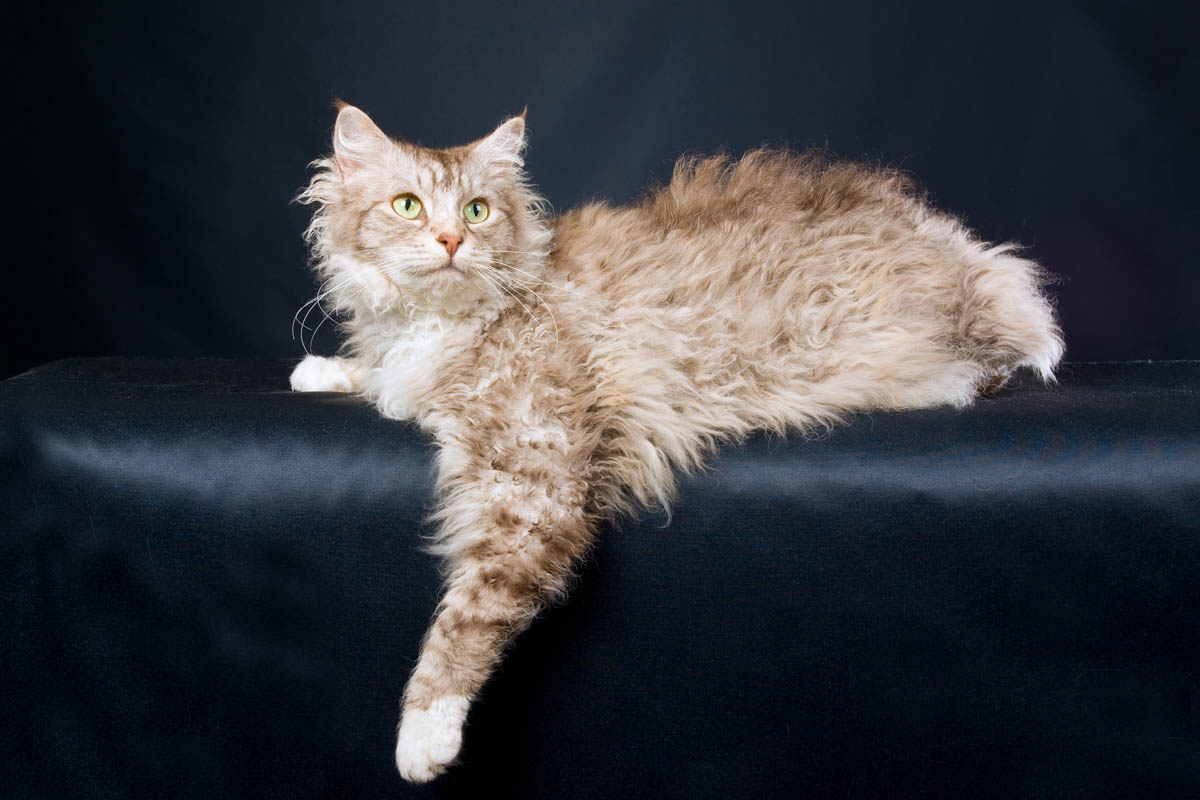
- Origin: 1982, Oregon, USA
- Lifespan: 12-14 years
- Eyes: Hazel, green, yellow, blue
- Energy: Medium
- Temperament: Playful, intelligent, loving and loyal
- Weight: Males 5-6 kg (11 – 13.2 lbs), females 4-5 kg (8.8 – 11 lbs)
- Colours: All colours and patterns
- Grooming: Daily
In 1982, a barn cat named speedy gave birth to six kittens on a farm owned by Linda and Richard Koehl. One of the kittens was completely bald at birth, but when it grew in, it was curly. Curly, as she was named also had the appearance of other Rex cat breeds as well as an unusually sweet nature.
Curly went on to have five male kittens, all of whom were born bald but grew the same curly coat within a few weeks. These boys went on to mate with local cats, including a black cat who also produced five curly-coated kittens.
The Koehl’s let these cats continue to breed, and it was not long before there were several curly-coated kittens. Linda researched this unusual trait and found it was due to a dominant rex gene. She went on to establish a breeding programme, and TICA granted the LaPerm new breed status in 1995 and championship status in 2003.
Personality:
The LaPerm is an intelligent, active, sweet, loving and loyal breed of cat. They have a dog-like nature and like to be close to their human family at all times.
They get along with people, including children and other pets and make an exceptional family pet.
Lykoi

- Origin: 2010, Tennesee, USA
- Lifespan: 12-14 years
- Eyes: Hazel, green, yellow, blue
- Energy: Medium
- Temperament: Playful, intelligent, loving and loyal
- Weight: Males 5-6 kg (11 – 13.2 lbs), females 4-5 kg (8.8 – 11 lbs)
- Colours: All colours and patterns
- Grooming: Daily
In 2010, a black domestic (Eve Havah) gave birth to two kittens in a rescue centre. Patti Thomas, a cat breeder in Virginia acquired the three cats as it was thought they may carry the same mutation as the Devon and Sphynx. Genetic tests determined that these cats did not carry the same gene.
The first pair (Silver Lining Wolfie and Ray of Hope) were born in 2010 to a black domestic cat (Eve Havah). The three cats were found in a rescue centre, Patti Thomas, a cat breeder in Virginia, acquired them as it was thought they may carry the same mutation as the Devon and Sphynx. Dr Lesley Lyons of UC Davies, California performed genetic tests, and it was determined that the Lykoi did not carry the same gene as the Sphynx or Devon Rex.
The three cats were given to Dr Johnny Gobble, a veterinarian, and his wife Brittany. The couple already had two cats with the same unusual coat (Hillbilly Moonshine and Opossum Roadkill). Together, these five cats founded the Lykoi breed.
Personality:
The Lykoi is a playful, inquisitive, intelligent and loyal cat who loves to be near their family. They have a strong prey drive due to their feral origins, and therefore it is best they stay indoors. Lykois are dog-like and wag their tails when they are excited.
Maine Coon

- Origin: Europe and USA
- Lifespan: 12-14 years
- Eyes: Hazel, green, yellow, blue
- Energy: Medium
- Temperament: Loyal, easygoing, intelligent, gentle
- Weight: Males 6-8 kg (13.2 – 17.6 lbs), females 5-7 kg (11 – 15.4 lbs)
- Colours: Solid, tabby, bi-colour and shaded
- Grooming: Daily
The Maine Coon has been around for many centuries and are a natural breed of cat. The exact origins are not known but it is thought they came to America from European countries and mated with native feral cats.
The Maine Coon was first exhibited at Skowhegan Fair which was held by New England farmers in the early 1860s. Twelve Maine Coons were present at the Boston cat show in 1878 and the first national cat show which was held in Madison square garden in 1895. The breed dropped off in the first half of the 1900s with the arrival of the Persian cat and in 1959 the Cat Fanciers Association declared the Maine Coon extinct in 1959 although this was considered to be an exaggeration. In fact, during this time, Ethelyn Whittemore of Augusta, Maine continued to breed Maine Coons and kept records of the parents and litters. Many of the Whittemore cats resurrected the breed and in 1953 the Central Maine Cat Club (CMCC) was formed by Alta Smith and Ruby Dwyer.
The Cat Fanciers Association awarded the Maine Coon championship status in 1975.
Personality:
Known for their dog-like qualities, Maine Coons are smart, loyal and will often bond with one person in the family. Their intelligence makes the Maine Coon easy to train.
Maine Coons love to climb and be up high, and water is also a favourite to drink, play in and sometimes swim.
Munchkin

- Origin: 1983, Louisiana, USA
- Lifespan: 12-15 years
- Eyes: All eye colours
- Energy: Medium
- Temperament: Playful, outgoing, easily trainable
- Weight: Males 5-6 kg (11 – 13 lbs), females 4-5 kg (8.8 – 11 lbs)
- Colours: All coat colours and patterns
- Grooming: Weekly
The Munchkin is a short-legged breed that came about when a cat was discovered in 1983 with short legs due to a spontaneous mutation. Teacher Sandra Hochenedel rescued two cats (Blueberry and Blackberry) both of whom ha,d short legs. Blueberry was found a home but Sandra kept Blackberry who was pregnant at the time of her rescue. Blackberry gave birth to four kittens two of whom had, the same short legs. One of these kittens (Toulouse) was given to Kay LeFrance and it is Blackberry and Toulouse who became the founders of the Munchkin breed.
The Munchkin was introduced to the public via a live cat show held at Madison Square Gardens and achieved championship status with TICA in 2003.
Personality:
Playful, outgoing and kitten-like well into adulthood, the Munchkin gets along with everyone including children and other pets. Munchkins love to play fetch and are easy to train to walk on a harness.
Nebelung
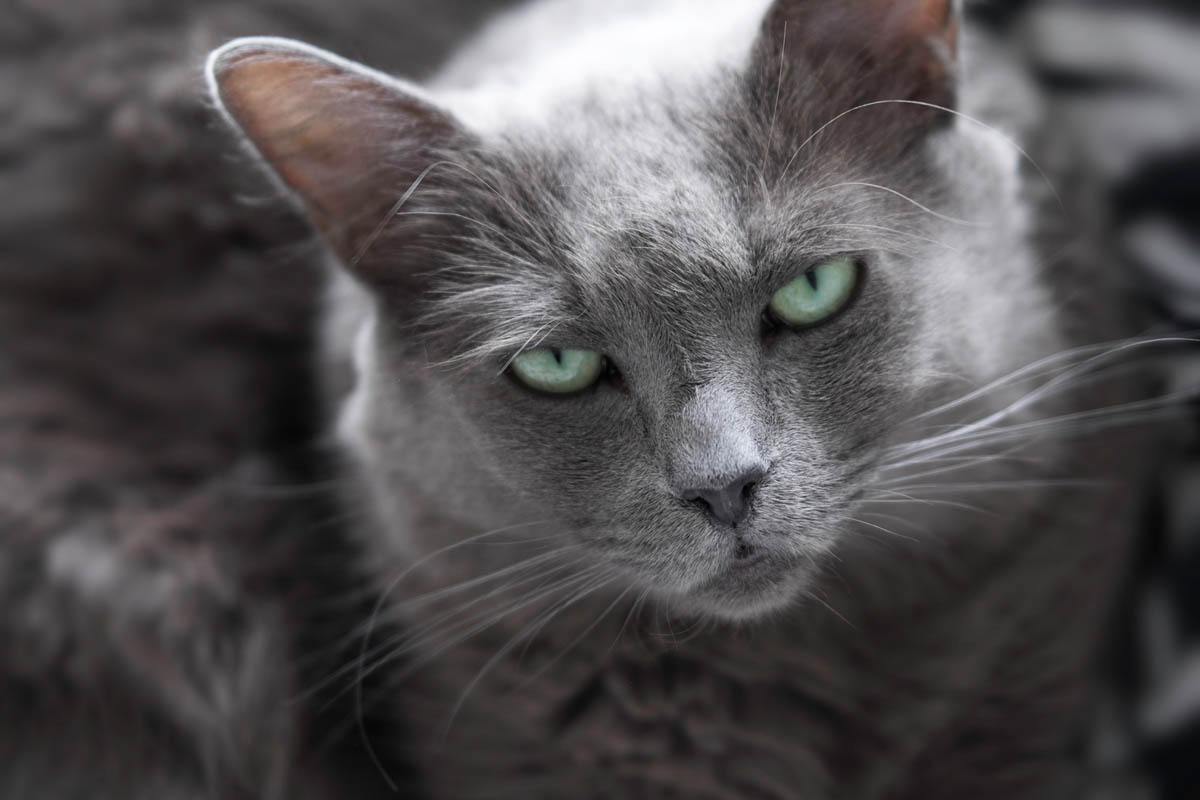
- Origin: 1984, Denver, Colorado, USA
- Lifespan: 12-14 years
- Eyes: Green or yellow/green
- Energy: Medium
- Temperament: Playful, intelligent, loving and loyal
- Weight: Males 5-6 kg (11 – 13.2 lbs), females 4-5 kg (8.8 – 11 lbs)
- Colours: Blue
- Grooming: Daily
Six kittens were born to Elsa, a black domestic shorthair and a blue longhaired father who had the appearance of an Angora. Five of the kittens had short hair like their mother, but one male, Siegfried, had a semi-long coat. Five months later, Elsa had another litter of seven kittens, which included two long-haired females, one black, one blue. The blue kitten, named Brunhilde as well as Siegfried went on to become the foundation cats for the Nebelung breed.
Siegfried and Brunhilde produced a litter of kittens in 1986, and Cora Cobb, the mother of Karl, who owned Elsa, decided to try and establish a new breed. Dr Solveig Pflueger of TICA advised Cora to create a breed standard based on the Russian blue, but with a longer coat.
The Nebelung was awarded new breed status in 1987 and championship status in 1997.
Personality:
Nebelungs are gentle and quiet; they can be shy with strangers but are loyal and loving with their owners.
Intelligent, playful and active, the Nebelung gets along with older children. They have a dog-like temperament and will often follow their human family from room to room.
Ocicat

- Origin: 1964, Michigan, USA
- Lifespan: 12-14 years
- Eyes: Gold, green and copper
- Energy: High
- Temperament: Confident, outgoing, dog-like
- Weight: Males 6-8 kg (13.2 – 17.6 lbs), females 5-6 kg (11 – 13.2 lbs)
- Colours: Tawny, Blue, Chocolate, Lavender, Cinnamon, Fawn, Black Silver, Blue Silver, Chocolate Silver, Lavender Silver, Cinnamon Silver, and Fawn Silver.
- Grooming: Weekly
The Ocicat is a man-made domestic cat named after the Ocelot from South America and was founded by Virginia Daly of Dalai cattery who mated an Abyssinian male to a Siamese. She aimed to produce an Abyssinian pointed Siamese. The litter had the Abyssinian type, and a kitten from this litter (Dalai) was mated to a chocolate point Siamese named Whitehead Elegante Sun. The next litter had Abyssinian points, with the exception of one kitten named Tonga, who had beautiful golden spots on a cream background. Tonga was neutered and sold as a pet, but Virginia repeated the same mating which produced more spotted kittens.
More breeders followed, and the American Shorthair was introduced to improve the type and introduce silver to the breed.
The CFA recognised the Ocicat in 1966 however the breed didn’t receive championship status until 1987.
Personality:
The Ocicat is confident, outgoing, intelligent and energetic with dog-like traits. Like their Siamese ancestors, Ocicats are a vocal breed and will follow their human companion from room to room.
Ocicats are extremely lively, confident, outgoing, intelligent and have many dog-like traits such as playing fetch.
Pixiebob
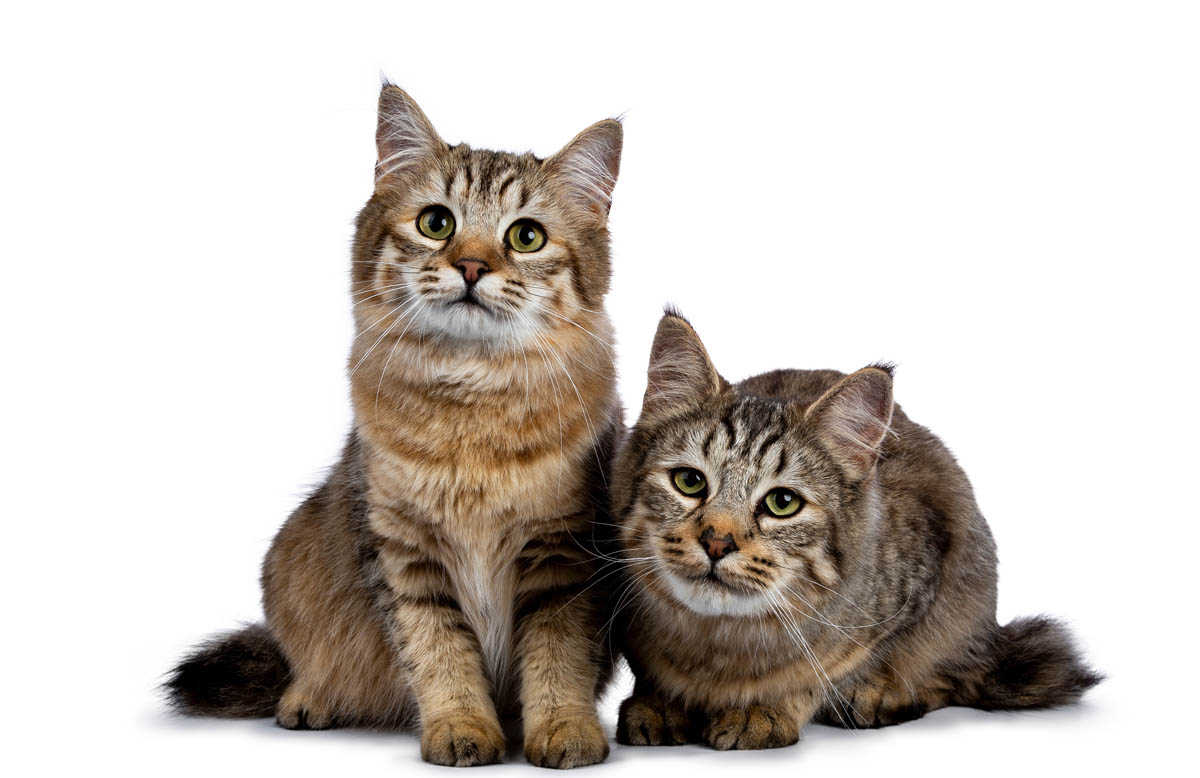
- Origin: 1985, Washington, USA
- Lifespan: 12-18 years
- Eyes: Gold to green
- Energy: Medium
- Temperament: Friendly, playful, easygoing, active
- Weight: Males 5 kg (11 lbs), females 4-5 kg (8.8 – 11 lbs)
- Colours: Brown tabby
- Eyes: Green to gold
- Grooming: Daily or weekly depending on coat length
Legend has it that the Pixiebob is a cross between a wild bobcat and a domestic shorthair, although DNA analysis has shown no bobcat genes in the Pixiebob. In 1985, Carol Ann Brewer of StoneIsland Cattery bought a short-tailed, polydactyl cat from the base of Mount Baker in Washington State. She later rescued a second male who also had a bobbed tail who was allegedly the offspring of a bobcat. This cat, Keba mated with the neighbour’s cat, Maggie and Carol kept one of the kittens, who was named Pixie.
Pixie had the appearance of a wild bobcat and Carol started a breeding programme. Other cats from Mount Baker were used to create the breed who were accepted for exhibition status in 1995 and new breed status the following year.
Personality:
Pixiebobs are intelligent, active, playful, curious and easy to train. Their friendly and personable nature means they make a great family pet who are known to form strong bonds with their human family.
RagaMuffin

- Origin: 1994, California, USA
- Lifespan: 12-15 years
- Eyes: All eye colours
- Energy: Medium
- Temperament: Loyal, easygoing, calm
- Weight: Males 6-7 kg (13.2 – 15.4 lbs), females 5-6 kg (11 – 13.2 lbs)
- Colours: All coat colours and patterns
- Grooming: Weekly
The RagaMuffin is a variant of the Ragdoll cat. Ann Baker (the Ragdoll founder) ran the International Ragdoll Cat Association (IRCA) and placed strict restrictions on Ragdoll cats. A group of Ragdoll breeders left the IRCA in 1994, however, because Ann Baker had trademarked the name Ragdoll. At this time, there were many Ragdolls with different coat patterns, when the group splintered, they had agreed not to use the name Ragdoll (which Ann had trademarked), so came up with the name RagaMuffin. Curt Gehm is credited with choosing the name RagaMuffin.
Outcrosses to domestic longhairs and Persians were permitted to improve the breed’s genetic health. Unlike the traditional pointed coat colour of the Ragdoll, the RagaMuffin is allowed in any colour and pattern.
The CFA accepted the RagaMuffin for registration in 2003 and full championship status in 2010.
Personality:
The RagaMuffin is a sweet, intelligent, affectionate and people-oriented cat. They not as energetic as other breeds and like the Ragdoll, can go floppy when picked up. Due to their slow maturity, the RagaMuffin stays kitten-like for many years.
Ragdoll

- Origin: 1960s, California, USA
- Lifespan: 12-15 years
- Eyes: Blue
- Energy: Medium
- Temperament: Loyal, easygoing, calm
- Weight: Males 6-7 kg (13.2 – 15.4 lbs), females 5-6 kg (11 – 13.2 lbs)
- Colours: Seal, chocolate, blue, lilac, red (flame)
- Grooming: Weekly
A white Persian/Angora type cat called Josephine who belonged to Ann Baker, a Persian breeder from Riverside, California was hit by a car. Ann took her to the veterinary hospital, where she claims Josephine was subjected to government testing, which resulted in her becoming relaxed when picked up and no longer felt pain.
Josephine had a litter of kittens who were larger than previous kittens and had the same laid-back nature as their mother.
Government conspiracies aside, Josephine had two boys to two fathers. Blackie, a female black cat and Raggedy Ann Daddy Warbucks, a cream cat with dark points and white mitts. These two cats became the founding fathers of the Ragdoll. Daddy mated with one of Blackie’s daughters, which produced two kittens. Raggedy Ann Tiki (Tiki) and Raggedy Ann Kyoto (Kyoto). Another daughter of Josephines, Buckwheat produced Fugianna, another founding cat.
Daddy Warbucks, Tiki, Kyoto and Fugianna who were registered as the first Ragdoll cats with the NCFA in 1966. Daddy Warbucks was listed as number one on the register.
Personality:
Ragdolls are laid-back and calm, despite claims by Ann Baker, they do feel pain, Ragdolls may hide it better.
The Ragdoll thrives on human companionship and never far from their family. It is not uncommon for a Ragdoll to choose a favourite person in the family. They get along well with everyone, including children and other pets.
Selkirk Rex

- Origin: 1987, Sheridan, Montana, USA
- Lifespan: 12-16 years
- Eyes: All eye colours
- Energy: Low to medium
- Temperament: Friendly, playful, easygoing, active
- Weight: Males 5 kg (11 lbs), females 4-5 kg (8.8 – 11 lbs)
- Colours: All coat colours and patterns
- Grooming: Weekly
A kitten with a curly coat was born to a litter of otherwise normal kittens in 1987. The mother and her babies had been taken to an animal shelter in Wyoming.
The kitten was named Curly-Q and found a home, but was quickly returned because she cried too much. Peggy Voorhees from the Boseman Humane Society took the kitten to Jeri Newman, a Persian breeder. Curly-Q was renamed Miss De Pesto and was mated to Photo Finish, a black Persian. The resulting litter contained three straight-haired kittens and three curly-coated kittens like their mother. The three curly-coated kittens consisted of, one was a black and white male (Noface Oscar Kowalski), one tortoiseshell female and one black female. Oscar was bred back to his mother, and four kittens were born, three curly-coated, one with straight hair.
The Selkirk Rex achieved championship status with the Cat Fanciers Association in 2000.
Personality:
Laid-back, with a similar disposition to the Persian and British shorthair. The Selkirk Rex loves to play but is not highly active as other breeds.
They are extremely sociable and get along with everyone including children and other pets.
Snowshoe
- Origin: Philadelphia, USA
- Lifespan: 12-14 years
- Eyes: Blue
- Energy: Medium
- Temperament: Friendly, playful, easygoing, active
- Weight: Males 4.5-5.5 kg (9.9 – 12.1 lbs), females 5-5 kg (8.8 – 11 lbs)
- Colours: Seal, blue, chocolate and lilac
- Grooming: Weekly
The Snowshoe was created by Siamese breeder Dorothy Hinds-Daugherty of Kensing Cattery. One of her Siamese gave birth to a litter of three who all had four white feet. Dorothy began a breeding programme by crossing seal point Siamese with bi-colour American Shorthairs. Dorothy abandoned the programme, but Vikki Olander of Furr-Lo Cattery took over. Vikki created the first breed standard for the Snowshoe and is responsible for its recognition. The breed was granted experimental status with Cat Fanciers Federation (CFF) and the American Cat Association’s (ACA) in 1974.
Snowshoes went into decline after this, and it looked as if it might vanish completely until Jim Hoffman and Georgia Kuhnell contacted Vikki. The three worked together to develop the Snowshoe. More breeders came on board and worked on updating the breed standard. The Snowshoe won championship status with the CFF in 1983.
The Snowshoe is still a rare breed, partly because the spotting gene is difficult to work with.
Personality:
The Snowshoe is gentle, loving, affectionate, and can be more vocal than other breeds but not as talkative as the Siamese.
They get along with other pets as well as children but tend to form a strong bond with one particular person in the family.
Somali
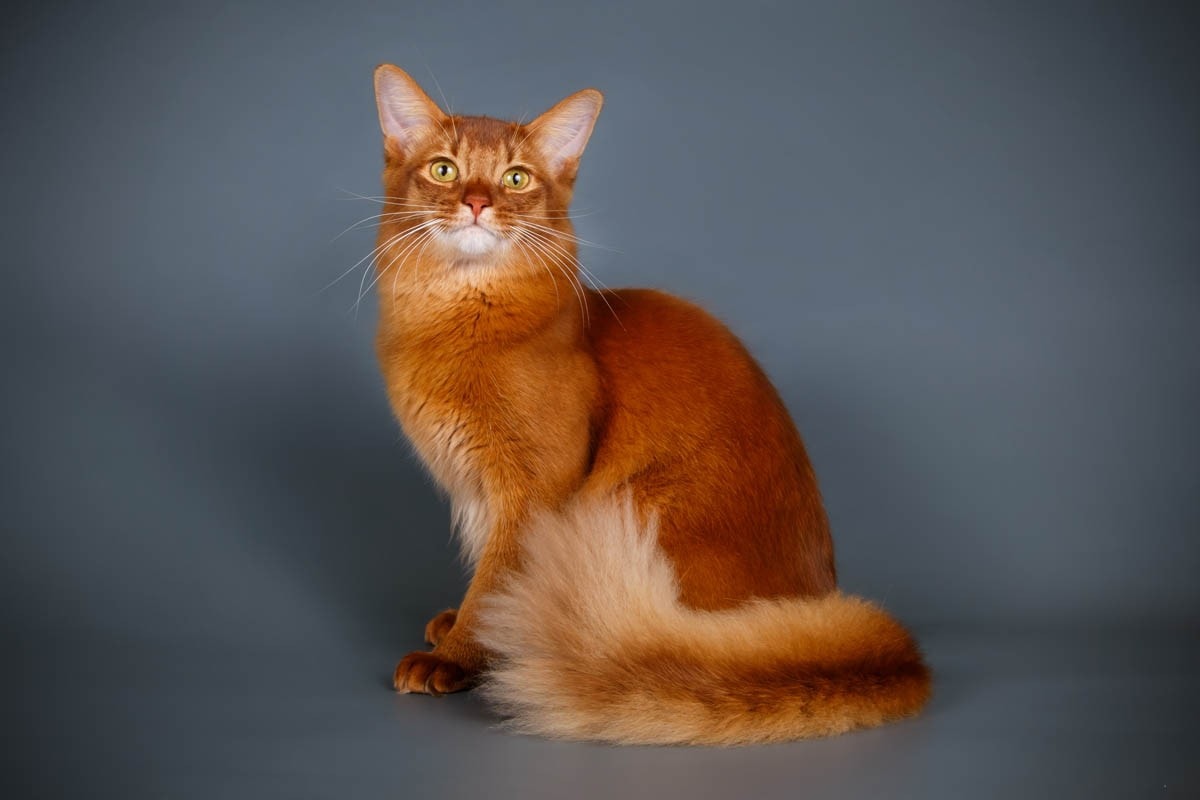
- Origin: USA
- Lifespan: 12-16 years
- Eyes: Gold to green
- Energy: Medium to high
- Temperament: Friendly, playful, easygoing, active
- Weight: Males 5 kg (11 lbs), females 4-5 kg (8.8 – 11 lbs)
- Colours: Red, blue, fawn, and silver
- Grooming: Weekly
From time to time, cats with a long coat would crop in Abyssinian litters and be sold as pets. In 1967, a mating between Charlott Lohmeyer’s Lo-Mi-R Trill By (Trilly) and Evelyn Mague’s Lynn-Lee’s Lord Dublin (Dubbies) produced an odd-looking, fuzzy coated kitten. George was given away at five weeks old but would go on to become the catalyst for the Somali breed.
At five weeks old, George was sent off to a new home. Evelyn also rescued cats and one day George was surrendered to Evelyn as his owner had developed allergies. George didn’t get on well with Evelyn’s cats and was found a new home. However, Evelyn felt it was unfair that these beautiful longhaired cats were so devalued and decided to develop them as a breed, despite much initial resistance.
The Somali Cat Club was formed in 1972, and the breed was exported to Europe in 1977 where breeding programmes were established. Back in the USA, Somali’s were awarded championship status with the CFA in 1978.
Personality:
Somali cats are similar in temperament to the Abyssinian; they are an active breed who love to be up high. This is a breed that is on the go all the time.
Their intelligence makes the Somali easy to train, and their extroverted nature makes them the ideal family pet.

